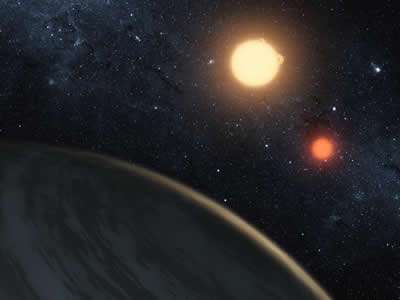An exoplanet orbiting a double star

(PhysOrg.com) -- The Kepler satellite, which has now reported the detection of 1781 candidate exoplanets (a planet around a star other than the sun), has also discovered that at least one of them orbits a double star. Each of the two stars in this new system is smaller than the sun (one is 0.2 solar-masses and the other is 0.69 solar-masses), and the planet, called Kepler 16, actually orbits around both of them (rather than orbiting only one).
A team of eight CfA astronomers, Samuel Quinn, Dave Latham, Guillermo Torres, Matt Holman, Robert Sefanik, Warren Brown, John Geary, and Dimitar Sasselov joined with colleagues to report the discovery of Kepler 16 in the latest issue of Science. Kepler detects exoplanets when they transit across the face of a star, dimming its light slightly and briefly; luckily, in this system the planet transits the face of each of the two stars as seen from Earth. The planet itself has a mass about that of Saturn's, orbits around the pair in 221 days, and has a surface temperature of around -125° Fahrenheit.
There is some popular, dramatic appeal to envisioning a planet with two stars (but, since most stars are binaries, there probably are many planets with two suns in their skies, even though they may only orbit one of them). There are, however, some useful scientific consequences of this system of three objects. In particular, models can determine precisely the masses and orbits of all the bodies.
In this system, the fact that the planet transits both stars also implies that it's orbit is closely aligned with the orbit of the two stars. This fact in turn suggests the important conclusion that probably the planet formed at the same time as the stars, rather than having been captured from elsewhere with a resultant orbit that would not likely be co-aligned. These and other details, like the shapes of the orbits, make Kepler 16 a particularly exciting and productive exoplanet probe as astronomers try to piece together how planetary systems are made and evolve.
Provided by Harvard-Smithsonian Center for Astrophysics


















